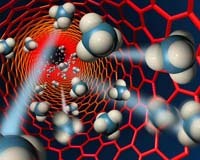Methane stands out among various alternative fuels when its profusion and availability are considered. However, the lack of an effective, economic and safe on-board storage system is one of the major technical barriers preventing methane-driven automobiles from competing with the traditional ones, say the study authors.

|
| ©Unknown |
In the past decade, a new type of highly porous crystalline materials called metal-organic frameworks (MOFs) have emerged as promising storage materials due to their high surface area, tunable pore size and modifiable surface. Several MOFs have been screened for methane storage but none have reached DOE target levels considered practical for fuel storage applications, the scientists say.
Their paper, published in the January 23 issue of the Journal of the American Chemical Society, describes the synthesis and structural characterization of the metal-organic framework (MOF) designated PCN-14, based on a pre-designed anthracene derivative. (PCN stands for porous coordination network).
PCN-14 contains nanoscopic cages suitable for methane storage, with a high Langmuir surface area of more than 2000 square meters per gram (m2/g). The methane uptake (absolute methane-adsorption capacity) of PCN-14 is 230 v/v - 28 percent higher than the DOE target of 180 v/v for methane and the highest ever measured.



Reader Comments